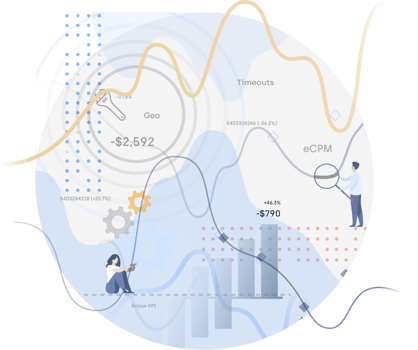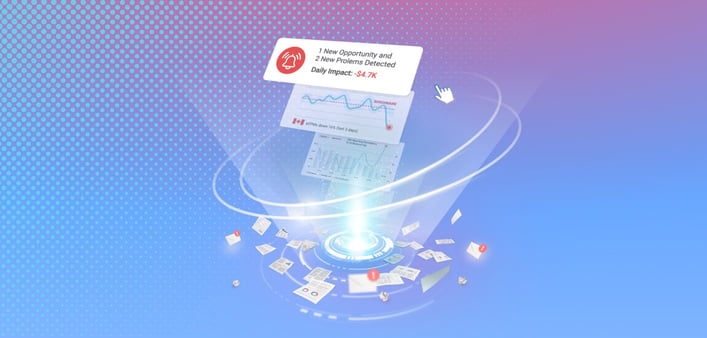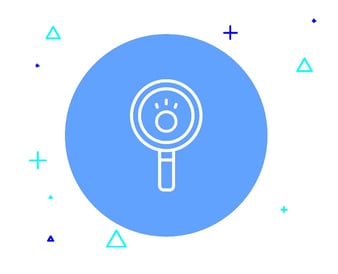Civilization as we know it owes itself to the Agricultural Revolution — the shift from hunting & gathering to proactively producing crops and livestock. This revolutionary change bore immediate fruit — both literally and metaphorically. Overnight human life went from struggle to strength. One day life was an exercise in subsistence and the next day there was prosperity to spare and possibilities untold.
Today, we’re at a similar crossroads. Only instead of being about how we come by our calories, it’s about how we come by our business insights.
The old system leverages dashboards and similar tools to help users collect data and hunt for insights. It produces value, but the process is inefficient and limited. The onus is on the user to go out and make hay. Success isn’t guaranteed, it’s slow, and invariably things are missed. How could they not be when most organizations only review some 12% of their data!
The new system takes a different approach. Leveraging machine learning and a well-mapped understanding of the connected nature of different data factors and business outcomes, businesses make their data work for them — delivering actionable insights to their doorsteps. This approach is vastly more time-efficient and cost-effective. Heck, it's much more effective period.
Today's Data Ops Are Held Back By Hunting & Gathering
It's been said that every digital business is a data business. And today every business is a digital business. But data is not itself valuable, the value comes through a derivative — through the insights. Insights are what direct businesses toward smart decisions and away from bad ones. Insights also provides an early warning system that sounds whenever problems or opportunities arise. The thing is that turning data into insights takes some doing.
It's a matter of both art and science and usually a fair bit of elbow grease too. If handled without great care, all that hassle can quickly turn your data from an asset to a liability. Indeed, data creates obligations (think privacy and security) and overhead well before a single step is taken to extract value from it.
And the process of extracting value from data is not cheap; demanding considerable time and energy, regardless of whether or not any real value is ultimately delivered. Worse still, those costs increase more or less linearly with the amount of data. For businesses that generate loads of data — like digital publishers do — that can turn their data operations into a black hole endlessly sucking in time and money.
Of course, there are tricks of the trade (and plenty of tools) that make it easier. But the most skilled hunter with the sharpest spear still can't compete with an average cattle rancher. And that's where we're at with today's data practices. We're still going through data manually, with the help of dashboards and crude alerting systems, in the hope of stumbling on a trace of something that'll lead us somewhere.
The Costs of The Old Way
The more data you collect, the more difficult it becomes to keep track of its goings on, and the more difficult it is to explain things in a timely manner. And as time becomes scarce, the need for automation becomes greater. Which is why 53% of digital Growth and Monetization professionals say their biggest day-to-day pain comes from manual and inefficient processes. But traditional automation tools are dumb and can't tackle any of the complex data tasks that consume so much of your time.
Growth and Monetization teams, have it particularly bad — typically spending 3+ hours every day prowling the savannas of their business information. They gather all of their mediation and attribution data looking for signs of life and they consult their visualization tools on the hunt for performance insights.
It's slow and meandering work. And the burden of carrying on with the traditional approach goes beyond wasted time.
-
Prone to Oversights
The traditional (hunter-gatherer) approach to mining data for insights is carried out in several stages. Generally, you'll first consult your dashboards — looking at your main KPIs. If those numbers appear more or less as expected, you'll move on to look at longitudinal plots for a selection of key metrics across strategic permutations. If any of your KPIs or longitudinal plots look off, you'll begin opening reports to dig into the contributing data points.
If everything looks normal, you may review those reports in a top-down manner — looking section by section at top-line values aggregating lower line performance. More likely though, if your main KPIs and strategic plots look okay, you'll move on to other tasks — ignoring the data points collected in your reports in the interest of saving time. And that's where we open up a lot of room for error.
-
Painfully Slow
If you do dig into those reports, however, most of your attention will be given to top-line figures. And only when those figures appear suspect, will you start inspecting individual lower level details. When that happens, you'll scrutinize all the subsetting metrics and parameters looking for any outlying factor(s) that might explain the deviation. That will give a clear location to focus your investigative energies as you endeavor to understand precisely what happened and how.

Ultimately, you'll need to have that understanding as well as a good working knowledge of how the issue impacts the business and what you can do about it. And that all comes down to old-fashioned investigative leg work — methodically following the tracks of your prey until it appears in sight. Knowing the root cause, the impact, the fixability, and the relevant available interventions, these hunter-gatherers can then weigh their options and chart a path forward.
Did we mention that it's a slow, inefficient process? Well it definitely is. So much so that analytics teams spend as much as 80% of their time collating, cleaning, and organizing data. And even then, the coverage provided remains patchwork at best. It's designed to ensure you survive; not that you thrive. And that's the pity of it.
-
Paltry Perspective
Worse still, since it only captures what its pre-defined to face and only goes where you take it, you can never hope to achieve real 360° visibility. Instead of a comprehensive living picture, you're getting snapshots.
If you don't know at what or where to look, you're guaranteed to miss whatever's going on there. It's the hunter-gatherer equivalent of a gazelle grazing just four feet from basecamp while you and the rest of the hunting party chase shadows on the other side of the plain.
Kickstart Progress With An Embrace Of Cognitive Analytics
To process enormous amounts data and derive concrete business insights, data operators need to embrace the revolution. At the heart of that revolution is cognitive analytics. Cognitive analytics combine machine learning algorithms, deep learning models, and context-aware relationship mapping to process data, define patterns, detect their deviations, and draw conclusions.
Better still, cognitive analytics feed all incidents and their uses back into the system to help it improve and better mimic expert human intelligence.
Rather than presenting a static view of the business, insight farming technologies proactively review EVERYTHING and alert managers to problems & opportunities — even anticipating where performance is heading. Knowing whenever any significant event happens across the entire field of play and span of time gives you a sort of super vision.
What's more, this grow rather than gather approach would automatically drill down on the relevant data dimensions and granularity levels for each affected metric — providing all the relevant information and context for fast and fool-proof follow up. It's that combination of capabilities that allows you to quickly get a handle of the situation and understand what actions to take or adjustments to make in order to improve performance.
So instead of chasing insights, insight farmers leverage cognitive analytics to automatically showcase them. With this new approach, Growth and Monetization teams will make much more efficient and effective use of their time — opening new operational possibilities.
The Benefits of the New Way
When looking at the transformative potential of insight farming, it's important to not only consider the costs, but the benefits too. In this case, the only limit to those benefits is the level of detail you want to get into. To keep the list as brief and non-boring as possible, we've taken a broad view — consisting of the 4 main benefits detailed below.
-
Faster response for greater impact
In a competitive market, speed is vital. Making sense of data metrics from multiple sources as quickly as possible is a persistent challenging. To succeed, Growth and Monetization teams need to be able to quickly translate raw data into meaningful insights and ultimately smart actions.

In fact, the faster teams respond, the more successful they will be. Whether it's catching and patching problems or recognizing and realizing opportunities, the shorter the gap between detection and correction the greater the gain. This is why Time-to-Response (alternatively captured as Time-to-Value or Mean Time To Repair) is considered such key performance indicator.
Consider for example that with oolo's smart alerting integrated into daily workflows, users typically see their response times shrink by a full 50%. But the more critical fact is that those faster response times directly translate into greater impact. Which is why, for example, UA professionals using oolo report ARPU (Average Revenue Per User) uplift of almost 30%, on average.
-
Improved overall productivity
The new approach saves considerable time and effort in managing data — from collection and normalization to health-checks and analysis. This allowing teams to focus on core business areas and key problems. It removes the complexities of monitoring rapidly changing variables and makes it easy for users to get a handle on their data — detecting subtle but significant anomalies, uncovering hidden trends, and unpacking complex relationships.
Just like the Agricultural Revolution, greater productivity is what it's all ultimately about. In the case of this new Data Revolution, the paradigm shift will be supported by workflow enablement technologies that give each individual user the ability to increase their productivity by orders of magnitude.
For a concrete demonstration of this benefit, consider the fact that oolo frees an average of over 5 hours per user per week. It's time that's re-invested into the business through other tasks and projects that the team wouldn't otherwise have gotten to; things like research, planning, experimentation, and optimization activities.
-
Reduced costs
 At the risk of stating the obvious and borrowing from Benjamin Franklin's famous adage "a penny saved is a penny earned", every cost avoided is a benefit incurred. Saving employees time preparing, modeling, and analyzing data allows the business to do more with less and contributes to a meaner, leaner organization. In fact, according to Deloitte, adopting a more agile approach to analytics can lead to data operations and project savings of some 20-40%.
At the risk of stating the obvious and borrowing from Benjamin Franklin's famous adage "a penny saved is a penny earned", every cost avoided is a benefit incurred. Saving employees time preparing, modeling, and analyzing data allows the business to do more with less and contributes to a meaner, leaner organization. In fact, according to Deloitte, adopting a more agile approach to analytics can lead to data operations and project savings of some 20-40%.
That's quite a lot of savings — especially when you consider the fact that data operations and projects typically account for some 39% of IT budgets, or 3.2% of the total budget!
-
Refocus
Of course all that time saved will inevitably have an effect on the work environment too. Dramatically drawing down the sense of chaos, the day-to-day office posture of will change from fire-fighting to fire-proofing. No longer on the back foot, employees will not only move on to items lower on their to-do lists, but they'll also be afforded the opportunity to regularly stop and think.
In one word, this is what we call the "refocus" effect. It's what happens when the team is allowed to operate in a less hurried and reactive manner and take a more thoughtful approach to their work. Sometimes it will lead to doing the same things in different ways, and sometimes it will lead to doing different types of things.
Either way, it's very likely to benefit the business. According to research from SHL, the "refocus" effect improves concentration levels for 32% of people and yields a 27% increase in overall performance. It can also lower burnout rates, boost morale, reduce turnover, and engender novel techniques/strategies. Heck, it may even benefit the business in an un-anticipatable that only becomes apparent after the fact.
The Current Inflection Point
With the costs and benefits so clearly backing a Data Revolution that sees insights raised rather than rummaged for, there are two obvious questions. First, why hasn't it happened yet? And second, what's different now?

The answer to the first question boils down to the fact that available solutions fail to properly map data relationships and business situations. This is because most AI is designed as a sort of academic instrument — built for data scientists rather than operations teams. Such solutions surface data changes rather than business problems and opportunities.
Without understanding how one metric impacts another and that one the next within the tangled web of causation and correlation, it's impossible to:
- Consolidate all related movements into a shared incident
- Trace a given incident to its data point of origin
- Understand the available levers of control for effective intervention
And without understanding how different data dynamics tie back into the core business and it's normal operations, it's impossible to:
- Distinguish what's just noise from what's really noteworthy
- Translate anomalies into addressable problems or opportunities
- Understand the business impact and dollar-value of a given incident
Without those capabilities in place, no technology no matter how advanced can make the leap from observation to interpretation. In other words, to support the revolution, we need technology that's able make sense of what it’s looking at — not just from a data perspective, but from causal and business perspectives too.
Building those capabilities into software requires a lot of subject matter, operations, and workflow expertise. It's a slow and expensive process that by definition results in a highly nichified solution. As such, most of the technology-providers with the chops to deliver on the technology front lack the business interest to pursue such solutions — preferring instead to focus on developing mass-market technologies.
 Which is why until now, even the best anomaly detection tools have lacked the business intelligence to see the story beyond the statistics. As a result, we're left with tools that may be great for data gathering and insight hunting, but always leave the onus on the user to go out and find the meat.
Which is why until now, even the best anomaly detection tools have lacked the business intelligence to see the story beyond the statistics. As a result, we're left with tools that may be great for data gathering and insight hunting, but always leave the onus on the user to go out and find the meat.
Today, however, that reality is changing. In fact, it's already changed. In oolo, for example, we've developed technology to automate hitherto manual analyses and shorten data review/investigation times.
With core algorithms, category insights, and business logic crafted and refined specifically for the industry's unique datascape and department's performance factors, we’ve successfully combined business understanding with data pattern recognition.
The result is a purpose specific cognitive analytics solution that doesn't just process and present data, but understands it — differentiating trivial data fluctuations from meaningful issues, tracing the causal factors, assessing the business impact, and modeling follow-ups to better the business.
And that's what's changed. The arrival of vertical and application specific AI tools suddenly make the coming Data Revolution seem both credible and imminent.
Consider the following real-world example from a large European mobile app publisher. Shortly after launching a new campaign through Mintegral, oolo alerted the UA manager to the fact that despite a marked increase in Mintegral installs, at the app level, there was no real change. Included in the alert was a view of Share-of-Voice (SOV) metrics over time. This gave the manager the full picture and showed the Mintegral campaign to be cannibalizing organic acquisition.
With this understanding in tow, the manager was able to quickly take action — halting the campaign and reallocating spend to other growth channels. (Later, the campaign would later be relaunched with changed targeting parameters.)
With oolo, it's a matter of insight farming. The story is told in minutes and the upshot couldn't any clearer — paving the way for swift follow up. Without oolo, it's hunting and gathering. The issue would likely have persisted for days if not weeks before ever being noticed. And even then it would have required hours of investigation before the problem shifts clearly into focus.
It's a banal example, but that's precisely why it's meaningful. For an operation of any significant size, you can expect to see a handful of these sorts of issues pop-up everyday. And that's why it's a great case in point to demonstrates the difference between the old way of doing things and the revolutionary way of doing things — the chase approach vs. the showcase approach.
Riding the Wave of Revolution
To get the most out of their operations, Growth and Monetization professionals need to continuously scan and scrutinize their datascapes. Today they do that with dashboards — starting everyday with a hunt. It's slow and tedious work bedeviled by blindspots. Even with the best tools and talent, this approach will never be able to keep of with the volume of data and speed of business.
The result is missed issues, inefficient labor allocation, and delayed interventions. Whether it's a matter of fixes or optimizations, those delays directly translate to lost money and squandered growth potential.
Which is why we're calling for change. Just like the Agricultural Revolution changed the way people sought out and thought about their calories, the next Data Revolution is sure to change how businesses extract and enact everyday insights. And it's a revolution that's coming whether you're on board or not.
Those businesses that embrace the data revolution will be the ones that succeed in the future. It will mean adopting purpose-specific cognitive analytics solutions and replacing hunter-gather data practices with insight farming.
In this new paradigm, work will revolve around and go through smart systems that deliver insights to your doorstep in near real time — so you can systematically review and leverage them at any scale. This will ensure perfect data observability and absolute context-awareness at all times.
It's a revolution that's already underway and that oolo is committed to accelerating. And while early adopters may enjoy the biggest and most immediate gains, we will all reap the benefits over time. If you're excited by the prospect of improved operational efficiency, faster and more precise iteration, and maintained strategic perspective, you'll soon find that this is truly a wonderful time to be alive.








